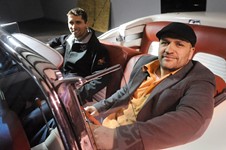From Hearses to Marital Arguments
By Jordan Smith, Fri., Aug. 16, 2013
Before ambulances, there were hearses.
Until the late Fifties, says Travis County EMS Medical Director Paul Hinchey, "half of the ambulance agencies in the nation were funeral home companies, so they just painted their hearses white instead of black." A hearse was the only vehicle long enough to accommodate a person lying down; the funeral home just picked you up, rolled you in the back, and, without providing any intervening care, took you where you needed to go – either to the hospital or the funeral home.
That's the way it was in Austin too, recalls Public Safety Commissioner Mike Levy, who in 1976 was tapped to sit on the city's nascent emergency medical oversight committee. The city went from funeral homes and hearses to trucks run by the same company that managed the UT shuttle buses, he recalls. Austin's experience wasn't unique; what passed for EMS "was a hodgepodge" of services across the country, said Austin-Travis County EMS Director Ernie Rodriguez, "and [with] really bad results." Starting about 1970 things began to change. Out-of-hospital paramedicine was developed on the battlefields of Korea and Vietnam, and success in saving soldiers there ultimately transformed the newly emerging field of EMS. "Wartime medicine drives a lot of what we do," said Hinchey, an emergency doctor by training who started working as a volunteer EMT on an ambulance while still in high school. In the mid-Seventies the pace of change accelerated, as the federal government released block-grant funding to support the development of professional EMS systems, says Rodriguez.
But surprisingly, it was the Seventies TV show Emergency! that imbued EMS with the kind of superhero street cred long enjoyed by police and firefighters. The show revolved around two Los Angeles paramedic/firefighters and a hospital emergency crew. It was "very dramatic," recalls Hinchey, with lights, sirens, IV bags, and drugs squirting out of the tips of needles; life and death situations – snake bites, heart attacks, a mid-air plane crash, a high-rise inferno. "They established in the national psyche ... what is supposed to happen when the ambulance shows up." And that expectation has remained fairly constant over the roughly 40 years of professional EMS in the U.S., including Austin.
Austin's foray into delivering EMS services followed the national timeline, but on a slightly different course. Unlike other early adopters – including L.A., where (as in the TV show) EMS was established as a fire department-based service – Austin ultimately decided to operate its EMS as a stand-alone, third public safety service, and to join forces with Travis County to provide a "regional" EMS system. Under this model, the city and county have jointly funded an agency dedicated to ambulance-based paramedic care.
That the system essentially functions as it did more than 30 years ago is both a blessing and a curse. On the upside, there's the relatively high esteem with which ATCEMS is regarded nationally, and the years it has spent honing its delivery of services to a unique population and geographic area. On the downside, in many ways ATCEMS operates also like a marriage in which issues between city and county have festered for years and have created a level of distrust that is hard to acknowledge, let alone to address and overcome. And as in so much marital discord – the flash-point issues are money and effective communication.
Got something to say on the subject? Send a letter to the editor.








